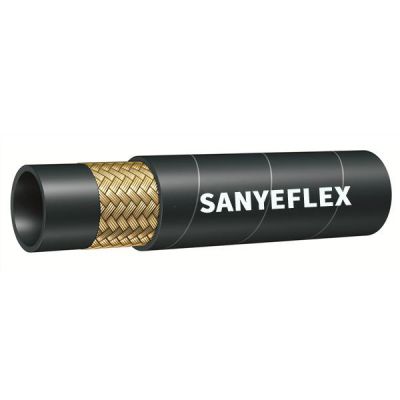Dec. 25, 2024
In this comprehensive guide, we will delve into the various types of industrial hoses, their applications, and how they play a pivotal role in different industries. Industrial hoses are essential components used in numerous applications across diverse sectors, such as manufacturing, construction, agriculture, mining, and more. Understanding the different types of industrial hoses is crucial for ensuring optimal performance, safety, and efficiency in various operations.
Industrial hoses are flexible, reinforced tubes designed to convey various fluids, materials, or gases under specific pressure and temperature conditions. These hoses are manufactured using different materials, each catering to specific industrial requirements. They are engineered to withstand harsh environmental conditions, abrasion, chemicals, and other challenging factors encountered in industrial settings.
2.1. Water Hoses
Water hoses are one of the most common types of industrial hoses, widely used in construction, agriculture, and general industrial applications. These hoses are designed to carry water and other non-corrosive liquids at low to medium pressures. Water hoses are typically made of durable rubber or PVC materials, providing flexibility and long-lasting performance.
2.2. Chemical Hoses
Chemical hoses are engineered to handle a wide range of corrosive and hazardous chemicals. They are widely used in chemical plants, refineries, and laboratories. These hoses are constructed with specialized materials such as EPDM, UHMWPE, or PTFE, ensuring resistance to chemical reactions and offering safe transfer of various substances.
2.3. Oil and Fuel Hoses
Oil and fuel hoses are designed to transport petroleum-based products like gasoline, diesel, and other fuel oils. These hoses are constructed with materials that can withstand exposure to petroleum products without degradation. Nitrile rubber and PVC are common materials used in the manufacturing of oil and fuel hoses.
2.4. Air and Pneumatic Hoses
Air and pneumatic hoses are utilized to transfer compressed air in industrial applications. They are commonly used in manufacturing plants, construction sites, and workshops. These hoses are built to endure high pressures and offer flexibility to facilitate easy handling and installation.
2.5. Steam Hoses
Steam hoses are engineered to handle high-temperature steam in various industrial processes. They are critical components in industries such as food processing, pharmaceuticals, and manufacturing. Steam hoses are reinforced with multiple layers to withstand the high-pressure steam, ensuring operator safety and operational efficiency.
2.6. Vacuum Hoses
Vacuum hoses are employed in applications where a vacuum or negative pressure is required. They find extensive use in material handling, industrial cleaning, and HVAC systems. These hoses are designed to resist collapse under vacuum conditions, enabling efficient material transfer and system operations.
2.7. Ducting Hoses
Ducting hoses are specialized hoses used for ventilation, fume extraction, and dust collection. They are crucial in industries dealing with harmful fumes and airborne particles. Ducting hoses are made from materials like PVC, polyurethane, or thermoplastic rubber, offering excellent flexibility and resistance to abrasion.
2.8. Welding Hoses
Welding hoses are specifically designed for welding applications, providing a safe and reliable means to transport gases like acetylene and oxygen. These hoses are constructed with a combination of synthetic materials, ensuring resistance to heat, flame, and abrasion, thereby safeguarding welders during their operations.
Selecting the appropriate industrial hose for a specific application is crucial to ensure the overall safety and efficiency of operations. Consider the following factors when choosing the right industrial hose:
3.1. Operating Conditions
Evaluate the temperature, pressure, and environmental conditions the hose will be exposed to during operation. Different hoses have varying temperature and pressure ratings, and selecting one that meets the application's requirements is essential.
3.2. Material Compatibility
Ensure that the hose material is compatible with the fluid or substance it will be conveying. Using an incompatible hose can lead to chemical reactions, degradation, and leaks, posing significant safety risks.
3.3. Flexibility and Bend Radius
Consider the required flexibility and bend radius based on the installation and movement requirements. Choosing a hose with appropriate flexibility prevents kinks and enhances durability.
3.4. End Fittings and Couplings
Select end fittings and couplings that are compatible with the hose and the connections in the system. Proper fittings ensure a secure and leak-free connection.
3.5. Safety Standards and Certifications
Check if the industrial hose meets relevant safety standards and certifications, such as ISO, FDA, or UL. Compliant hoses are designed to adhere to stringent quality and safety regulations.
Regular maintenance and inspection of industrial hoses are essential to prolong their lifespan and prevent potential accidents. Here are some maintenance tips:
4.1. Visual Inspection
Regularly inspect the hoses for signs of wear, damage, or leaks. Replace any worn-out or damaged hoses immediately.
4.2. Cleaning and Storage
Clean the hoses regularly to remove debris and contaminants. Properly store them in a cool, dry place away from direct sunlight and extreme temperatures.
4.3. Training and Education
Train employees about proper hose handling, installation, and safety protocols. Educated staff can identify potential issues and take preventive measures.
In conclusion, industrial hoses are essential components that facilitate fluid and material transfer in various industries. Understanding the different types of industrial hoses and their applications is crucial for making informed decisions and ensuring safety and efficiency in industrial operations. When selecting an industrial hose, consider the operating conditions, material compatibility, flexibility, end fittings, and safety certifications. Regular maintenance and inspection are vital to extend the hoses' lifespan and prevent accidents. We are an industrial hose supplier. If you are interested in our products, please contact us now!
Previous: What Are Industrial Hoses Made of?
Next: What is the Use of Industrial Hose? A Comprehensive Guide
Our Customer
Tel.: +86 400 0318 111
Email: admin@sanyeflex.com
Add.: #218 Zhongke Street, High-tech Zone, Hengshui City, Hebei Province, China



